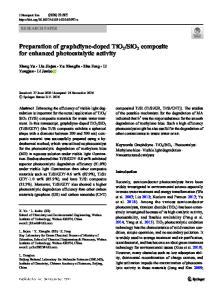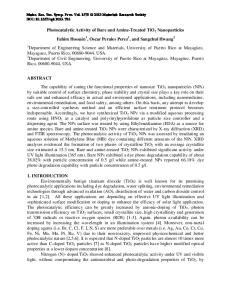Increasing the Photocatalytic Activity by Mechano-chemically Milling on Zn- Doped TiO 2
- PDF / 1,667,340 Bytes
- 21 Pages / 612 x 792 pts (letter) Page_size
- 12 Downloads / 429 Views
1217-Y03-34
Increasing the Photocatalytic Activity by Mechano-chemically Milling on Zn- Doped TiO2 Li Chennan1, Sesha Srinivasan2, Paula Algarin1, Nikolai Kislov3, Ayala Phani4, Elias Stefanakos1, Yogi Goswami1 1
Clean Energy Research Center, College of Engineering, University of South Florida, Tampa, FL, USA 2 Department of Physics, CEAPS, Tuskegee University, Tuskegee, AL, USA 3 NanoCVD Inc., University of South Florida Campus, Tampa, FL, USA 4 Nano-RAM Technologies, 98/2A, Anjanadri, 3rd Main, 3rd stage, vinayaka Layout, Vijayanagar, Bangalore 560040, India ABSTRACT This paper pursed one new cost effective strategy to improve the photocatalytic activity of the sol-gel developed Zn doped TiO2 by mechano-chemically milling in high energy planetary mill. The results showed that the photocatlytic activity was improved two times due to the increase of the surface area and the decrease in average crystallite size at the same time after using the high energy ball milling. Kubelka-Munk spectra of pristine and ball milled samples revealed a blue shift from 3.2 eV to 3.35 eV, which may be because of the presence of quantum size effects. SEM microstructural investigations revealed variations in the surface morphology with different Zn doping concentrations in the TiO2-Xwt.% Zn nanoparticulates. EDS spectra of these samples confirmed the stoichiometric concentration of Zn. Other characterization including X-ray diffraction (XRD), BET surface and the photocatalytic decomposition were also studied and the results were in agreement with each other. Keywords: Zn doped TiO2, mechano-chemically milling, sol-gel, photocatalytic
1. INTRODUCTION Water pollution is one of the main problems affecting the environment due to waste products generated by industries and households. This has lead to research on different disinfection methods. Among them, solar photochemical technology seems promising because it could disinfect most pollution at low cost by using cheap sources of energy, i.e. the sun. Solar photochemical technology is the technology that efficiently collects solar photons and uses them to promote specific chemical reactions which are called photocatalysis [1, 2]. The titanium dioxide (TiO2) is the most widely used photocatalyst. It has emerged as an excellent photocatalytic material for environmental purification because of its high stability, low cost, non toxicity, high oxidation potential and chemically favorable properties [3]. However it only utilizes the UV portion of the solar spectrum as an energy source (less than 4% of the total sunlight energy). This behavior is due to its high band gap value of 3.2 eV. In order to enhance the photocatalytic activity, researchers have tried a number of modification methods including noble metal doping, composite semiconductors and transition metal doping etc. Among the most widely used modification methods, transition metal doping has aroused great interest since this method can enhance the activities of a TiO2 photocatalyst in many types of photocatalytic reactions [4]. Zhao et
Data Loading...











